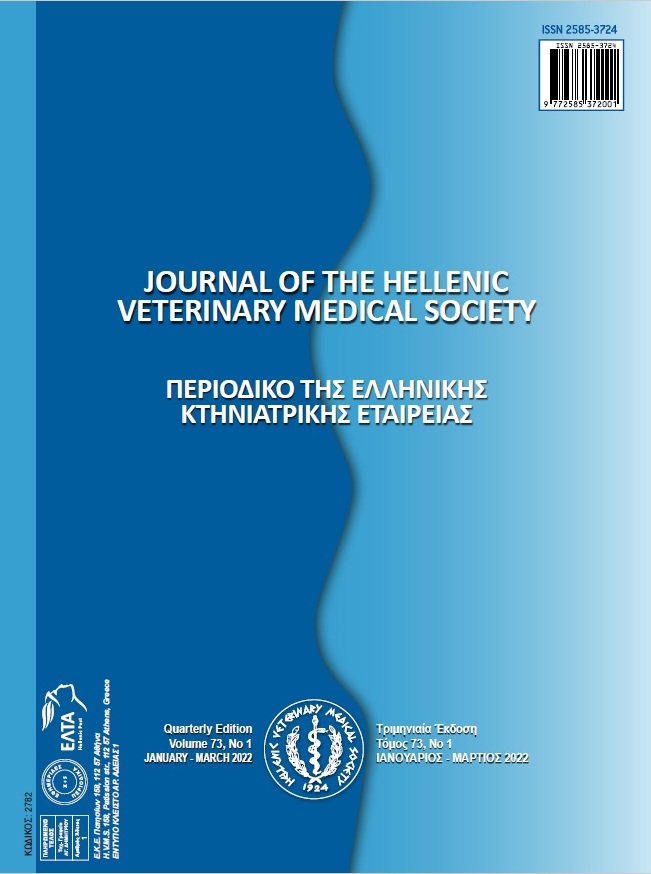Equine arteritis virus seroprevalence and risk factors in horses in the inner Aegean and Central Anatolia regions of Turkey
Περίληψη
Equine viral arteritis (EVA) is one of the most important respiratory and reproductive diseases of horses. This study aimed to investigate the seroprevalence of equine arteritis virus (EAV) infection and risk factors associated with seropositivity in clinically normal horses (n=262) in the inner Aegean region and Central Anatolia region of Turkey. This cross-sectional study was conducted by collecting sera samples (n = 262) from ambling horses raised in small family-type enterprises (n=65) during the months of February 2014 and February 2017. Epidemiological data were obtained from animal owners during blood sampling. An indirect enzyme-linked immunosorbent assay (ELISA) kit was used to detect specific antibodies against EAV in sera samples. Potential risk factors were determined by univariate logistic regression analysis. According to the test results, 8.40% (95% CI:5.61-12.39) seropositivity was detected in horses. While seropositivity rates by age were 2.47% in animals under 4 years of age, they were determined to be 11.05% in animals aged over 4 years (p=0.02). There was a statistically significant correlation between age, participation in races and festivals, precautions taken against rodents and insects at enterprises and EAV infection seropositivity (p<0.05). The findings obtained from this study are important in terms of informing breeders about the presence of this infection, taking infection-related biosecurity measures, and fighting the disease.
Λεπτομέρειες άρθρου
- Πώς να δημιουργήσετε Αναφορές
-
Ince, O. B., & Sevik, M. (2022). Equine arteritis virus seroprevalence and risk factors in horses in the inner Aegean and Central Anatolia regions of Turkey. Περιοδικό της Ελληνικής Κτηνιατρικής Εταιρείας, 73(2), 4159–4164. https://doi.org/10.12681/jhvms.26849
- Τεύχος
- Τόμ. 73 Αρ. 2 (2022)
- Ενότητα
- Research Articles

Αυτή η εργασία είναι αδειοδοτημένη υπό το CC Αναφορά Δημιουργού – Μη Εμπορική Χρήση 4.0.
Οι συγγραφείς των άρθρων που δημοσιεύονται στο περιοδικό διατηρούν τα δικαιώματα πνευματικής ιδιοκτησίας επί των άρθρων τους, δίνοντας στο περιοδικό το δικαίωμα της πρώτης δημοσίευσης.
Άρθρα που δημοσιεύονται στο περιοδικό διατίθενται με άδεια Creative Commons 4.0 Non Commercial και σύμφωνα με την άδεια μπορούν να χρησιμοποιούνται ελεύθερα, με αναφορά στο/στη συγγραφέα και στην πρώτη δημοσίευση για μη κερδοσκοπικούς σκοπούς.
Οι συγγραφείς μπορούν να καταθέσουν το άρθρο σε ιδρυματικό ή άλλο αποθετήριο ή/και να το δημοσιεύσουν σε άλλη έκδοση, με υποχρεωτική την αναφορά πρώτης δημοσίευσης στο J Hellenic Vet Med Soc
Οι συγγραφείς ενθαρρύνονται να καταθέσουν σε αποθετήριο ή να δημοσιεύσουν την εργασία τους στο διαδίκτυο πριν ή κατά τη διαδικασία υποβολής και αξιολόγησής της.




